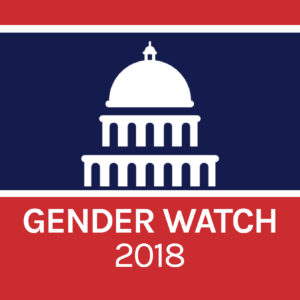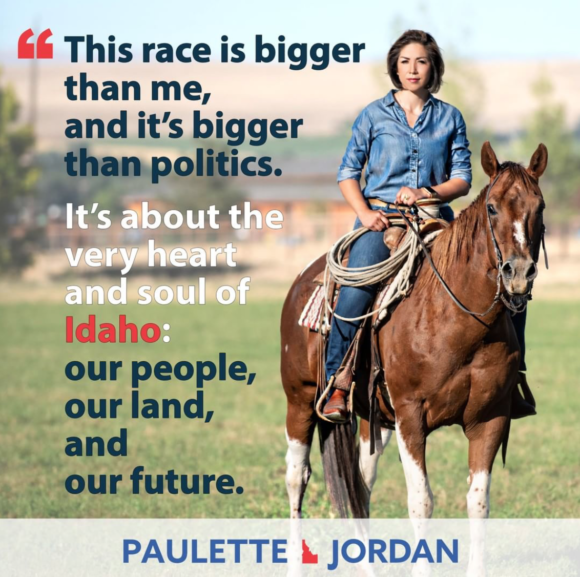Native American Women Running for Office Experience Boost This Year
 From March to December 2018, the Barbara Lee Family Foundation (BLFF) and the Center for American Women and Politics (CAWP) partnered to offer Gender Watch 2018, which tracked, analyzed, and illuminated gender dynamics in the 2018 midterm elections. With the help of expert scholars and practitioners, Gender Watch 2018 furthered public understanding of how gender influences candidate strategy, voter engagement and expectations, media coverage, and electoral outcomes in campaigns. The blog below was written for Gender Watch 2018, as part of our collective effort to raise questions, suggest answers, and complicate popular discussions about gender’s role U.S. elections.
From March to December 2018, the Barbara Lee Family Foundation (BLFF) and the Center for American Women and Politics (CAWP) partnered to offer Gender Watch 2018, which tracked, analyzed, and illuminated gender dynamics in the 2018 midterm elections. With the help of expert scholars and practitioners, Gender Watch 2018 furthered public understanding of how gender influences candidate strategy, voter engagement and expectations, media coverage, and electoral outcomes in campaigns. The blog below was written for Gender Watch 2018, as part of our collective effort to raise questions, suggest answers, and complicate popular discussions about gender’s role U.S. elections.
As Gender Watch contributors have noted, the upcoming elections are seeing large numbers of women of color running for office and, notably, this includes large numbers of Native American women running for office at the local, state and national level–many of whom would constitute historic firsts. While in past years Native American women’s campaigns have been closely watched, including Denise Juneau’s run for Montana’s at-large seat in the U.S. House in 2016, the political efforts this year are unprecedented.
The Candidates
Some of the most closely watched races with Native women candidates are for the U.S. House of Representatives. This includes Sharice Davids (Ho-Chunk) for Kansas’ third district and Deb Haaland (Laguna Pueblo) for New Mexico’s first district. Together, they would constitute the first Native American women in Congress. Paulette Jordan (Cour d’Alene) is running for the Governor’s seat in Idaho and could become the first Native governor in the U.S. In fact, of the Native American candidates running in 2018, women candidates outnumber male candidates, with Native women running in 57 state and national races, while Native men are running in 50. This includes 47 women running for state legislative seats across the country, which has the potential to dramatically increase the number of Native women currently holding legislative seats, now standing at 22.
In terms of campaigns, the Native candidates have chosen a variety of ways to appeal to voters. Haaland has emphasized her family’s military background. Interestingly, Paulette Jordan has positioned her Indigenous identity alongside her attachment to Idaho, which she argues means she will always put Idaho first. She has also sought to show herself as very much an “Idahoan” through the use of western style apparel and frequent horse riding in videos and promotional advertisements. Both of these examples highlight the way that Native American candidates may feel a need to emphasize their relatability to voters, which can include challenging voter stereotypes of Native women.

Sharice Davids has taken a more radical approach. In one advertisement video entitled ‘Fighting for Progress’ she spars in a boxing studio and outlines her identity as a Native American, lesbian MMA fighter. In the ad, she says “I’ve always had to fight: because of who I am, who I love, and where I started. But I didn’t let any of that get in my way. In Congress, I’ll continue fighting for everyone who’s ever been left out or left behind.” Work by Dittmar has demonstrated how women candidates, like Davids, may feel challenged to prove their masculinity, which is often a trait that voters assume male leaders hold. In the Davids ad, she is asserting her masculine traits of ‘toughness’ and ‘strength,’ especially with the tagline that she ‘never backs down’ and is ready for a fight. An additional ad, ‘The Ring,’ highlights how Davids’ was raised by a single mother who was a drill sergeant in the military, which helped instill the importance of service and hard work in Sharice Davids and encouraged her approach: “like mother, like daughter.” This dynamic ad was funded by Emily’s List PAC ‘Women Vote!,’ which already spent nearly $400,000 on advertising for the Davids’ primary race in Kansas.
Representations of the women from their competitors show the difficulty Native candidates, in particular women, can face when running for political office. Criticism has included the questioning of tribal identity and whether or not a candidate was raised on a reservation, proximity of ties to a tribal super PAC, and stance on immigration policy.
Immigration specifically has become a touchstone issue for Native candidates across the country. Opponents have pressed that these candidates are likely too lax on issues of border security and the undocumented. Haaland’s opponent suggested that she was unsuited to issues of immigration due to tribal limitations to provide law enforcement, while opposition advertisements against Davids suggest her statement on defunding ICE makes her radical, “unsafe,” “extreme,” “too risky” and “dangerous.” A Kansas Democratic national committeeman also suggested that Davids’ skin tone had been darkened in the ads, calling it “a lot of dog whistle.” The implication that these candidates are not trustworthy and even dangerous is not new. Such portrayals harken back to the “Cowboys and Indians” trope of dangerous Natives which was used in media depictions of the #NoDAPL efforts. These negative stereotypes and close association with immigration policies are aligning Native women’s experiences with other racial/ethnic minority women, especially Latinas.
Not all media attention has been negative. Beyond the distinction of potentially being a “first,” candidates are garnering attention for their high profile endorsements. Thus, their ‘first’ distinction can bring both political advantages and disadvantages. Recently, former president Barack Obama announced his endorsement of Davids, and National Republican Congressional Committee just days ago withdrew advertising funds from the Davids’ race after Inside Politics designated the race as leaning Democratic. Davids also has strong campaign backing from both progressive organizations and the Democratic Party, which has enabled her to outraise her opponent Yoder over the summer. Similarly, Haaland has been endorsed by both Obama and former vice president Joe Biden.
While the majority of the Native candidates are Democrats, there are also Green Party, Independent and Republican Native American candidates running this year. Yvette Herrell (Cherokee Nation) is running as a Republican for New Mexico’s second district seat. Republican women are running for state legislatures, including Charisse Millett (Inupiaq) in Alaska, Sharon Clahchischilliage (Navajo) in New Mexico, and Tamara St. John (Sisseton Wahpeton) in South Dakota. Before she withdrew, Eve Reyes Aguirre (Calpolli) of the Green Party was running for Senate in Arizona. Most notably, we already know that Minnesota’s next Lieutenant Governor will absolutely be a Native American woman, as Democrat Peggy Flanagan (White Earth Band) and Republican Donna Bergstrom (Red Lake Band) are not only both Ojibwe, but also vying against one another for the same position. Strikingly, a number of the candidates on both sides of the aisle are positioning themselves as Native tribal members uniquely situated to work along bi-partisan lines because of the distinct needs they have seen within their tribal communities. As many of the candidates are running in states where their party is in the minority, such a stance is necessary.
Native American Political Participation: Why Now?
More people are taking note of the high number of Native women running. Journalist Mark Trahant has been tracking the candidates, as well as their tribal affiliations, using the hashtags #SheRepresents and #NativeVote18. The tracking is in part crowdsourced, possibly due to the invisibility frequently faced by Native Americans within the political system. They have long been on the outskirts of mainstream politics, not even considered citizens of the United States until 1924, and faced significant barriers to voting and running for office well into the twentieth century.
While notable individuals have achieved political office, including U.S. Senator Ben Nighthorse Campbell (Northern Cheyenne) and controversial 31st Vice President Charles Curtis (Kaw Nation), there remains a tangible glass ceiling on Native American women’s political aspirations. There have been closely watched races, including the viable Denise Juneau (Mandan, Hidatsa, and Arikara Nation) who ran for House of Representatives in Montana to Ralph Nader’s Green Party Presidential running mate, Winona LaDuke (White Earth Band), but nothing to the extent currently anticipated in this year’s election.
Why now? There are many possibilities. Perhaps Native women have been inspired by seeing other Native women running in past elections, or it could be motivated in part by dissatisfaction with President Trump’s previous actions toward Native Americans. Many have expressed frustration with his statement, “They don’t look like Indians,” in relation to a dispute over federal recognition for an east coast tribe and Indian gaming disputes. Frustrations could certainly stem from his stance on land management issues, a key policy issue for many Native American groups, including support of the Dakota Access Pipeline and similar proposed projects, or the shrinking of Bears Ears National Monument.
On the other hand, the urgency felt this year could stem from persistent concern over the disproportionately high rate of gendered violence against Native American women. This past year, notable cases included the murder of pregnant Savanna LaFontaine-Greywind and the abduction and sexual assault of an Alaskan Native woman (known only by the initials L.K.) where the perpetrator was issued no jail time through a plea deal. Likewise, the Violence Against Women Act, which provides tribes with additional legal recourse for specific instances of gendered violence, is expiring this year and is another possible motivating policy issue.
No matter what has motivated Native American women to run for office this year, their presence and contributions merit our attention. Native women’s political representation is far overdue and their underrepresentation will not be remedied in one election cycle. In highlighting the successes of Native women this year, we shed a spotlight on the work left to do in raising their voices and experiences in all halls of American government.

